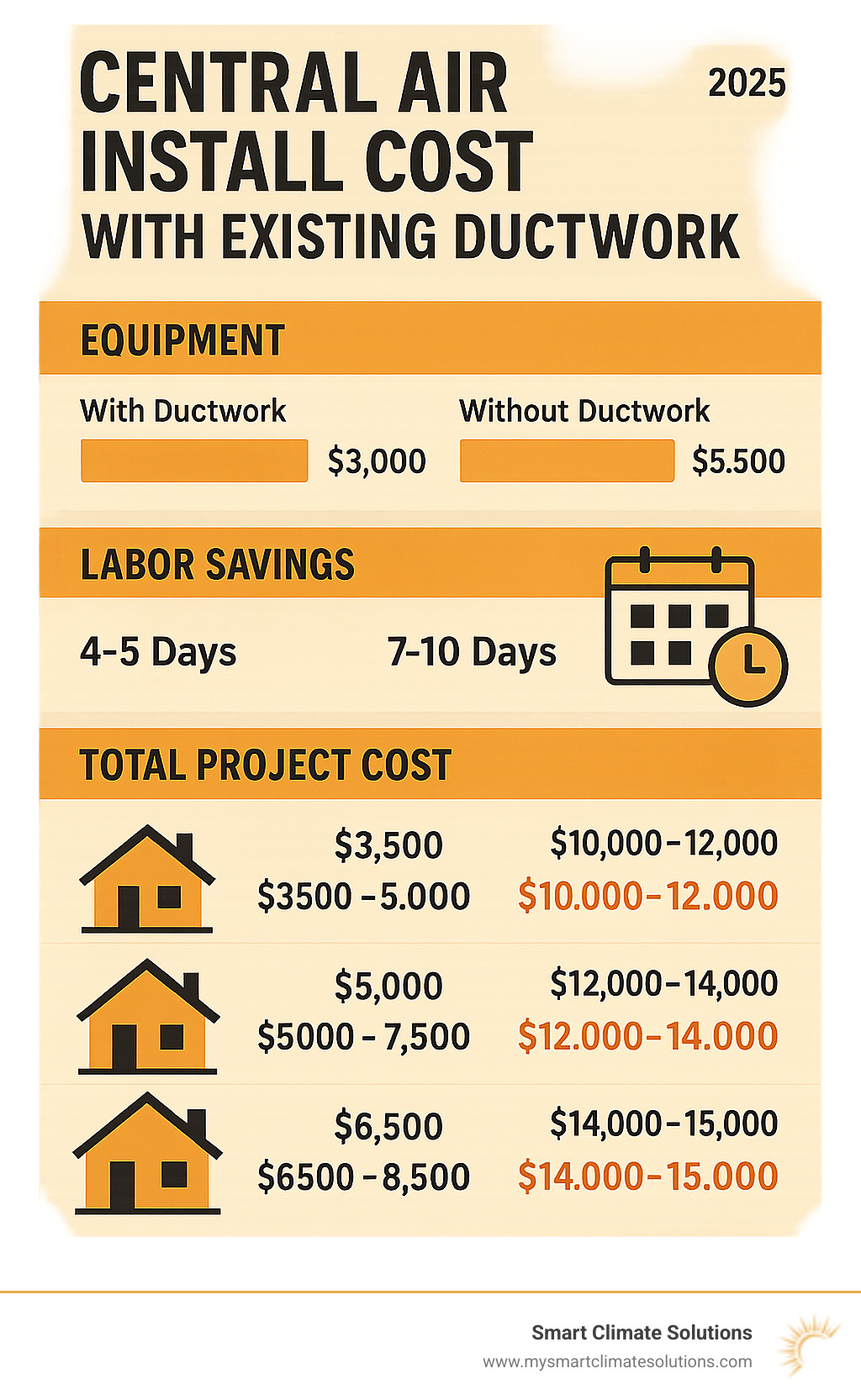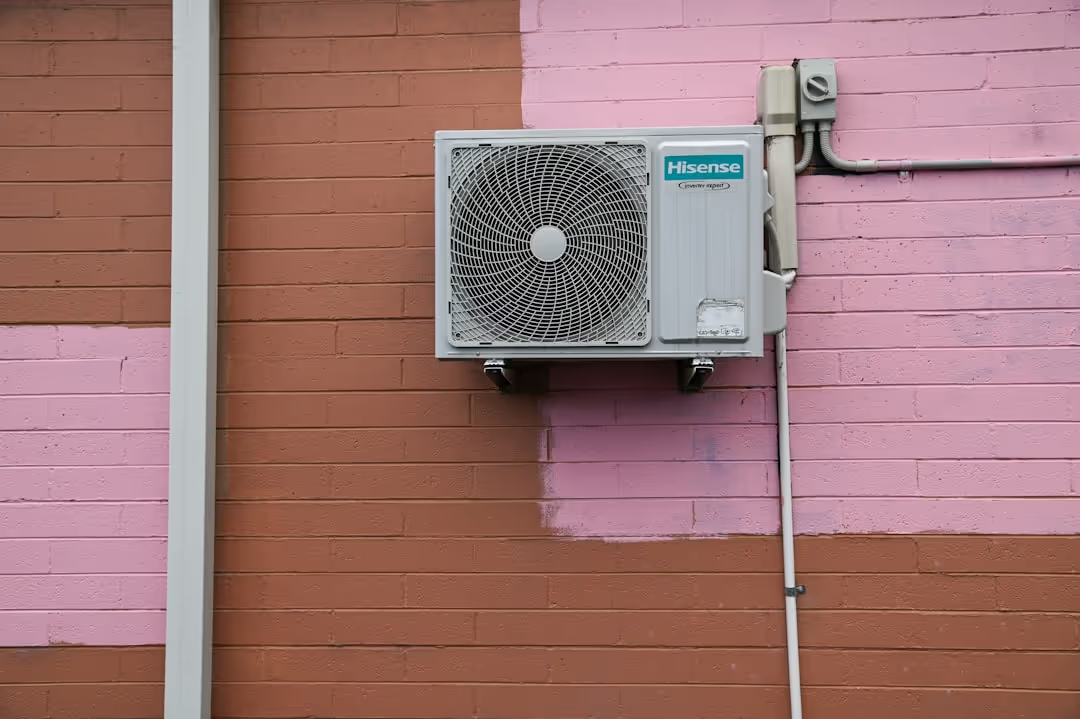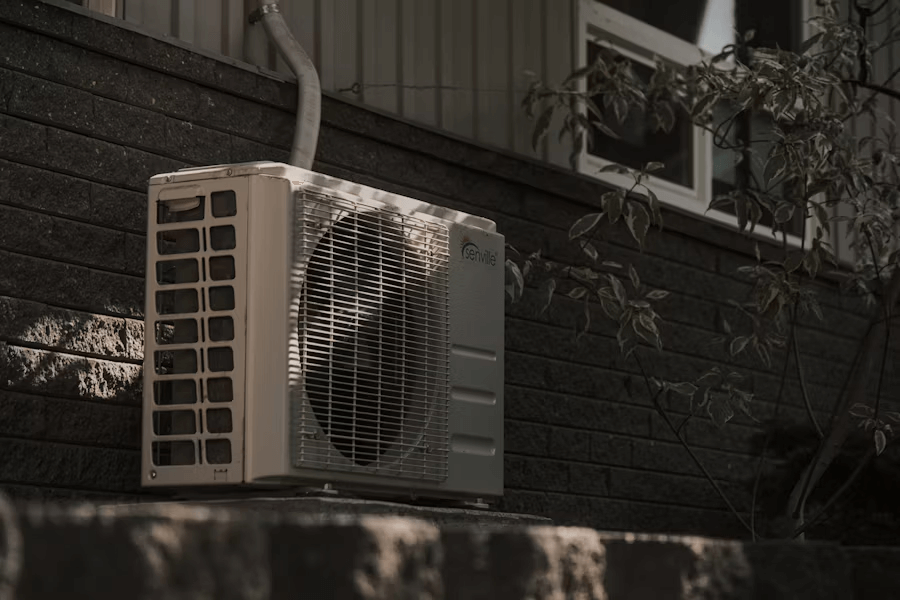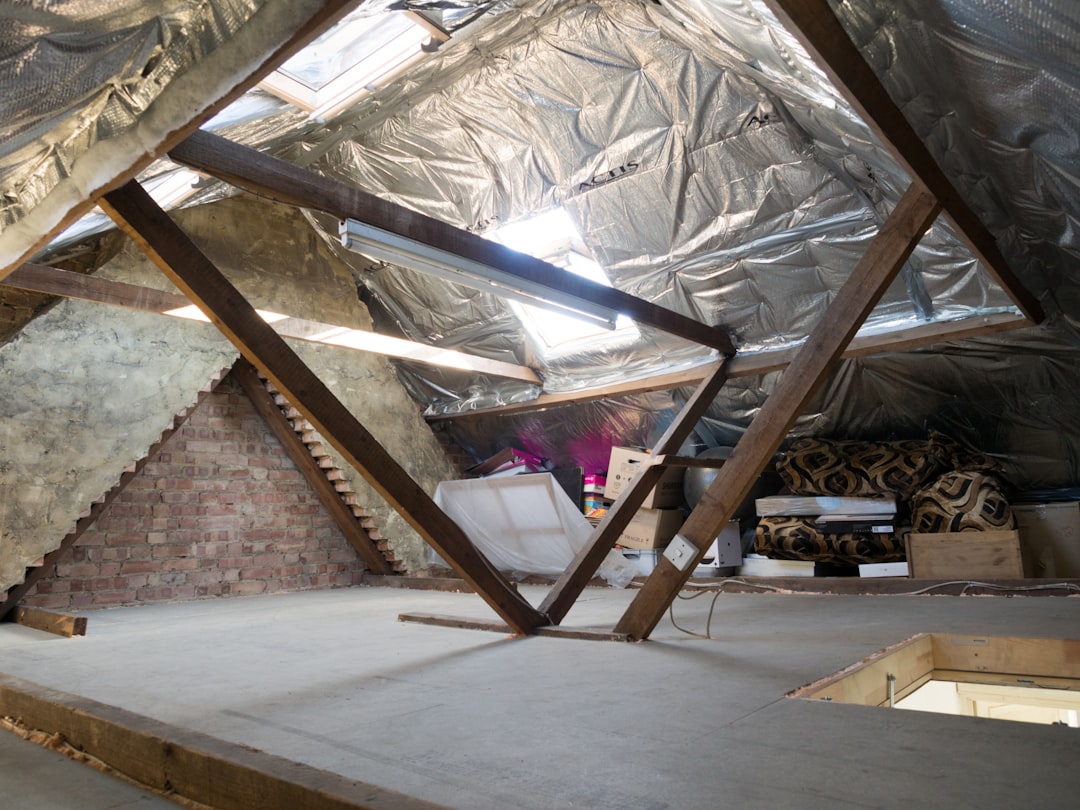Why Understanding Central Air Installation Costs Matters for Your Home
Central air install cost with existing ductwork usually lands between $3,500 and $8,500, roughly half the price of systems that require brand-new ducts.
Quick Cost Overview:
- 1,000 sq ft: $3,500 – $5,000
- 2,000 sq ft: $5,000 – $7,500
- 3,000 sq ft: $6,500 – $8,500
- Equipment: 60-70 % of the bill
- Labor: 25-30 %
- Permits & extras: 5-10 %
Because the air-distribution network already exists, your HVAC crew can finish in a day or two—no wall demolition, no messy drywall repairs, and far fewer labor hours. That’s the core reason your budget stays low.
Inspect first, though: aging or poorly sealed ducts may still need quick fixes such as mastic sealing or insulation. Those small upgrades protect efficiency and keep long-term operating costs down.

Simple central air install cost with existing ductwork glossary:
Why Existing Ductwork Slashes Your Bottom Line
Think of existing ductwork as a pre-poured foundation: the toughest, priciest part is already done. Skipping new ducts typically saves $5,000-$7,000 and trims the schedule from a week to 1–2 days.
No wall cuts means no surprise carpentry bills or dust storms inside your living room. Instead, technicians focus on mounting equipment, connecting to the ducts, and dialing in airflow.
Inspect Before You Invest
Before celebrating the savings, let a pro examine your ductwork:
- Duct sealing: $300-$800 to stop 20-40 % air leakage.
- Insulation check: $1.50-$3.00 per linear foot if attic or crawl-space runs are uninsulated.
- Blower test: Confirms ducts can move the air your new system needs.
Most forced-air heating ducts pass with only minor tweaks, but older or undersized systems may need quick upgrades so you keep reaping efficiency gains.
Central Air Install Cost With Existing Ductwork: National Averages
When you're budgeting for central air install cost with existing ductwork, you're looking at a much friendlier price range than homeowners who need new ducts installed from scratch.
The national average falls between $3,500 and $8,500 for most installations, with the final cost depending on your home's size, the system you choose, and your local market conditions. That's roughly half what you'd pay for a complete system with new ductwork.
Basic installations with standard 14-15 SEER systems and minimal duct modifications run $3,500 to $5,000. Mid-range projects featuring 16-17 SEER systems with some duct sealing and insulation upgrades cost $5,000 to $7,500. Premium installations with high-efficiency 18+ SEER systems and comprehensive duct improvements can reach $7,500 to $8,500 or more.
The per-square-foot math works out to approximately $2.50 to $4.25 per square foot for homes with existing ductwork. Compare that to $5.00 to $7.50 per square foot when new ducts are required.
Your equipment costs will eat up the biggest chunk of your budget at 60-70% of the total project cost. Labor typically accounts for 25-30%, while permits and miscellaneous fees round out the remaining 5-10%.
Cost Breakdown: Equipment, Labor, Permits
Understanding where every dollar goes helps you make smart decisions and avoid getting overcharged. When you're planning your central air install cost with existing ductwork, here's exactly how your investment breaks down.
Equipment makes up the lion's share of your budget. Your outdoor compressor unit will cost between $1,800 and $4,500, depending on size and efficiency rating. The indoor evaporator coil that mounts on your existing furnace runs $600 to $1,200. You'll also need a refrigerant line set to connect everything together, which costs $300 to $600.
Don't forget about the smaller but essential pieces. A programmable or smart thermostat adds $150 to $500, while miscellaneous parts like electrical disconnects and drain pans typically run $200 to $400.
Labor costs are where you see the biggest savings with existing ductwork. Your HVAC technician charges $75 to $150 per hour for typically 8 to 16 hours of work. You might need an electrician for $100 to $200 to handle electrical connections.
Permits and extras round out your budget. Your mechanical permit runs $50 to $200 depending on your local municipality. If electrical work is needed, expect an electrical permit for $25 to $100.
Central Air Install Cost With Existing Ductwork by Home Size
Your home's square footage directly drives your central air install cost with existing ductwork because bigger homes need more powerful systems to keep everyone comfortable.
Smaller homes around 1,000 square feet need a 2 to 2.5-ton system, with costs ranging from $3,800 to $5,200. These installations typically take just 1 to 2 days since smaller homes often have simpler duct systems.
Mid-size homes around 2,000 square feet require 3 to 3.5-ton systems, pushing costs to $5,200 to $7,200. Installation still takes 1 to 2 days, though multi-story homes might need zoning systems.
Larger homes around 3,000 square feet need 4 to 5-ton systems, with costs ranging from $6,800 to $8,500. These installations typically take 2 to 3 days and often require two-stage systems or zoning for optimal comfort.
Extra-large homes over 4,000 square feet need 5+ ton systems or multiple units, with costs starting at $8,500 and climbing past $12,000.
Central Air Install Cost With Existing Ductwork by System Tonnage
The tonnage - or cooling capacity - your home needs plays a huge role in your central air install cost with existing ductwork.
2-ton systems provide 24,000 BTUs of cooling capacity, perfect for 800 to 1,200 square foot homes. These systems cost $3,500 to $5,000, with basic 14 SEER2 units starting around $1,800 and high-efficiency 18+ SEER2 models reaching $3,500.
3-ton systems deliver 36,000 BTUs and work well for 1,200 to 1,800 square foot homes. Expect to pay $4,200 to $6,200 for these popular systems, which offer the widest selection of efficiency options.
4-ton systems pump out 48,000 BTUs, ideal for 1,800 to 2,400 square foot homes. These systems cost $5,000 to $7,500, and high-efficiency 4-ton units often provide the best long-term value.
5-ton systems blast 60,000 BTUs of cooling power for homes over 2,400 square feet. Costs range from $6,500 to $9,000 or more, with limited residential options.
The SEER2 rating significantly impacts costs across all tonnages. Higher efficiency units cost more upfront but save money on utility bills for years to come.

Hidden Factors That Still Influence Your Final Price
Even with existing ductwork giving you a head start, several sneaky factors can bump up your central air install cost with existing ductwork beyond those baseline estimates.
Your duct condition tells the real story of what you'll pay. Ducts installed before 1990 often need serious attention. If your ducts are wrapped in asbestos insulation (common in older homes), you're looking at special handling procedures that can add $1,000 to $3,000 to your project. Those flexible ducts that have collapsed or disconnected over the years need replacement at $8 to $15 per linear foot.
Accessibility can make or break your budget too. When your ducts snake through tight crawl spaces, finished basements, or areas where our technicians need to practically become contortionists, labor costs climb.
Electrical upgrades surprise many homeowners. Central air systems need dedicated 240-volt circuits, and older homes often can't handle this demand. If your electrical panel dates back to the disco era, you might need upgrades costing $500 to $2,000.
Refrigerant type matters more than you might think. Today's systems use R-410A refrigerant, which requires different handling than the older R-22 systems. If your existing line set isn't compatible, replacement runs $400 to $800.
Duct Repairs & Upgrades
Even ducts that look "good enough" often need some love to work their best with your new central air system.
Leak sealing is usually the first priority. The average home loses 20 to 30% of its cooled air through duct leaks. Professional sealing using mastic or aeroseal technology costs $800 to $1,500, but it can cut your cooling bills by 15 to 20%.
Insulation upgrades make a huge difference, especially for ducts running through hot attics. Uninsulated ducts can lose 30 to 40% of their cooling capacity. Adding R-6 to R-8 insulation costs $2 to $4 per linear foot, but the comfort improvement is dramatic.
Airflow balancing ensures your new system doesn't work harder than necessary. Existing ducts might send too much air to some rooms and not enough to others. Balancing dampers and airflow adjustments typically add $200 to $500 to your project.
Return air adequacy is something many homeowners never think about. Your system needs to breathe, and insufficient return air ducts can strain your new equipment. Adding return air ducts costs $300 to $600 per room but prevents premature system failure.
For comprehensive information about HVAC duct installation and when upgrades make sense for your home.
Efficiency & Brand Choices
Your efficiency and brand decisions create the biggest swings in central air install cost with existing ductwork.
SEER2 ratings set the efficiency baseline. New standards require systems to meet minimum ratings of 13.4 in northern regions and 14.3 in southern areas. Basic 14-15 SEER2 systems offer the lowest cost, while good 16-17 SEER2 units add $800 to $1,500 to your investment. High-efficiency 18+ SEER2 systems bump costs by $1,500 to $3,000 but can cut your cooling bills significantly.
Variable-speed technology represents the premium tier of comfort. These systems adjust their output to match your home's exact needs, providing superior comfort and efficiency. They add $1,000 to $2,500 to your system cost.
ENERGY STAR certification opens doors to rebates and tax credits, though certified systems typically cost 10 to 15% more than standard efficiency models. The good news? Those rebates often offset the premium completely.
Regional Labor & Permit Costs
Where you live creates significant differences in central air install cost with existing ductwork.
Urban areas like Pittsburgh, Cleveland, and Charleston typically see higher labor rates ranging from $85 to $150 per hour. Higher living costs and stricter permitting requirements drive these increases. Permit fees in cities often run $100 to $300.
Rural areas often offer lower labor rates of $65 to $100 per hour, but limited contractor availability can create its own challenges. Travel time and scheduling constraints sometimes offset the lower hourly rates.
Inspection requirements vary dramatically by municipality. Some areas require electrical, mechanical, and final inspections, each costing $50 to $150.
Smart Ways to Save and Pay for Your Project
Nobody wants to overpay for central air installation, and the good news is you don't have to. There are several proven strategies to reduce your central air install cost with existing ductwork without cutting corners on quality or reliability.
Tap Rebates and Tax Credits
Government and utility incentives can put serious money back in your pocket - sometimes enough to cover 20-30% of your total installation cost.
Federal tax credits are your biggest opportunity right now. The federal 25C tax credit provides up to $2,000 for qualifying high-efficiency systems, and you have until December 31, 2032 to take advantage of it. Your system needs to meet specific efficiency requirements, but most modern units qualify.
Utility rebates are like finding money in your couch cushions. Many utility companies offer rebates of $300-$1,500 for installing high-efficiency systems. The best part? These rebates often stack with federal tax credits.
Don't overlook state and local incentives either. Some states offer additional rebates or tax credits for energy-efficient home improvements.
Manufacturer rebates pop up seasonally, typically offering $200-$800 off equipment costs. These are usually available during slower periods when manufacturers want to keep production lines moving.
Use the Energy Star rebate finder to identify all available incentives in your area.
Financing Options That Won't Break the Bank
If paying cash isn't in the cards, several financing options can help spread your central air install cost with existing ductwork over manageable monthly payments.
Home equity loans offer some of the lowest interest rates available, and the interest is often tax-deductible. The downside is using your home as collateral and dealing with closing costs.
Home equity lines of credit (HELOCs) provide flexibility with variable interest rates and interest-only payments initially. They're perfect if you're planning other home improvements.
Zero-percent credit cards can be a smart choice if you have excellent credit and can pay off the balance within the promotional period.
Contractor financing offers convenience and often includes promotional rates. Many contractors partner with financing companies to offer competitive terms.
Personal loans don't require collateral but typically come with higher interest rates and shorter repayment periods.
Off-Season Scheduling & Multiple Quotes
Timing and shopping around can save you hundreds or even thousands on your project.
Winter installation is your secret weapon for savings. Installing central air during winter months (November through February) often results in 10-20% lower costs because demand is lower.
Getting multiple quotes isn't just smart - it's essential. Prices can vary by 20-30% for identical work. Always get at least three quotes from licensed contractors.
Avoiding peak season saves money and stress. Summer installations command premium pricing because everyone wants air conditioning when it's hot.
Search for contractors on the ACCA website to find qualified professionals in your area.
Installation Timeline & What to Expect From Your Contractor
With ducts already in place, most projects wrap up fast—usually 6–8 hours in one day, or two days if electrical or duct upgrades are added.
Pre-Installation Evaluation
A quality contractor will still run a Manual J load calculation and, when needed, a blower-door or duct camera test (about $250-$400 total). These prevent oversizing and reveal hidden duct issues before installation day.
Day-Of Installation Process
- Equipment delivery & staging
- Outdoor unit placement on a level pad
- Indoor coil attachment to your existing furnace
- Refrigerant line-set routing & electrical hook-ups
- Vacuum, refrigerant charge & test run
Post-Install Testing & Maintenance
Technicians verify refrigerant levels, calibrate your thermostat, and review the maintenance plan (annual tune-ups run $150-$300). A little preventative care keeps that new system humming for 15-20 years.
Frequently Asked Questions About Central Air With Existing Ducts
How long does the install take when ducts are already in place?
Here's the good news: central air install cost with existing ductwork includes faster installation times compared to new construction. Most installations wrap up in just 1-2 days, which is a huge relief when you're dealing with summer heat.
For straightforward installations - think newer homes with well-maintained ductwork and proper electrical service - we can often complete everything in a single day. Your family could be enjoying cool air by dinnertime!
More complex situations need a bit more patience. If your home needs electrical upgrades or your ducts require sealing and insulation work, plan for 2-3 days total.
Several factors influence your timeline. Single-stage systems go in faster than fancy variable-speed models. New circuit installation adds 2-4 hours to the job. Duct sealing and insulation work can extend things by half a day.
The bottom line? Most families are back to comfortable living within 48 hours of starting the project.
Will I need to upgrade my electrical panel?
This question keeps many homeowners up at night, but let's break it down simply. Central air systems are power-hungry - they need dedicated 240-volt circuits rated for 30-60 amps depending on your system size.
You'll likely need upgrades if your home was built before 1980. Back then, electrical panels were smaller and homes used less electricity overall. If your main panel is less than 200 amps, you're probably looking at an upgrade. No available spaces for new circuit breakers? That's another red flag.
Sometimes the existing wiring doesn't meet current safety codes, even if there's space in the panel. This isn't about making your life difficult - it's about keeping your family safe and your home protected.
Electrical upgrades typically cost $500-$2,000 but they're absolutely necessary for safe operation. Improper electrical installation can cause fires, damage your expensive new air conditioning system, or create safety hazards.
Think of electrical upgrades as an investment in your home's infrastructure. You're not just adding air conditioning - you're modernizing your electrical system for years of reliable service.
Does central air boost my home's resale value?
Absolutely! Central air conditioning is one of those home improvements that pays dividends both while you live there and when you sell. Real estate agents consistently report that homes with central air sell faster and command higher prices than those relying on window units or fans.
The value boost depends on where you live. In hot climates like the South and Southwest, central air can add $2,000-$5,000 to your home's value. In moderate climates, you're looking at a $1,000-$3,000 increase, which often covers a significant portion of your installation cost.
Even in cooler climates, central air improves your home's marketability. Buyers appreciate the comfort and convenience, even if they don't use it often.
But here's the real value: your daily comfort and quality of life. Central air provides consistent temperatures throughout your home, better humidity control, and improved air filtration. Many families find their energy costs actually decrease compared to running multiple window units.
When you factor in the central air install cost with existing ductwork being relatively affordable, plus the immediate comfort benefits and long-term value increase, it's hard to argue against the investment.
Conclusion & Next Steps
By leveraging your existing ducts, central air install cost with existing ductwork stays in the sweet spot of $3,500 – $8,500. Combine that with utility rebates, an off-season install date, and a high-efficiency unit, and you gain year-round comfort without straining your wallet.
Next steps are simple:
- Schedule a professional duct evaluation.
- Collect at least three quotes from licensed, insured contractors.
- Ask about rebates, financing, and any required electrical upgrades—better to know now than later.
Smart Climate Solutions serves Western Pennsylvania, southeastern Ohio, and northern West Virginia with certified technicians and 24/7 support. Ready to get started? Visit our HVAC installation services page or call 724-255-5103 for a free estimate today.







.png)
